Six hidden gems of Le Marche
We’re big fans of the Le Marche region of Italy; an amazing region which has been described by many as ‘the new Tuscany’. It’s authentically Italian, with fantastic food, stunning scenery and steeped in history – an unspoilt region which is well and truly worth adding to your bucket list. We take a look at some of the hidden gems that you’ll want to explore during your stay at one of our Marche villas.
Furlo Gorge
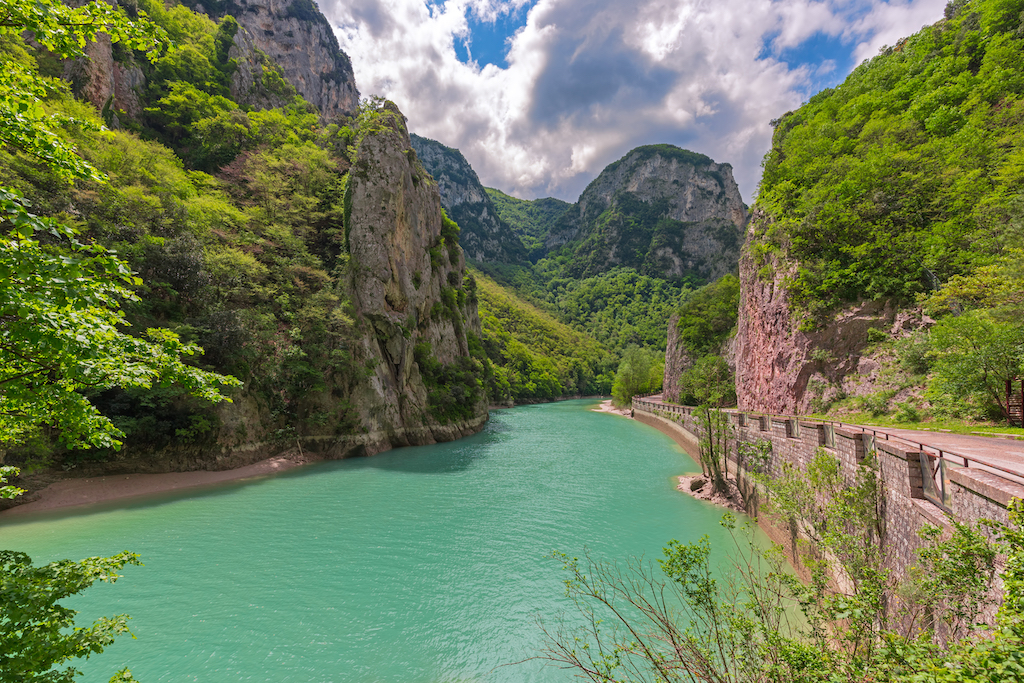
At the end of the Apennine chain, where you would expect mountains to turn into hills before reaching the coastline towards east, lives one of the most beautiful hidden gems of Le Marche.
Furlo Gorge is a spectacular gorge between the Mount Pietralata and the Mount Paganuccio, shaped by river Candigliano and now part of a nature reserve. Home of a great number of animal species – including wolves, deer, owls, peregrine falcons and the rare golden eagle – this gorge is a true paradise for those who love nature, trekking and breath-taking views. Both mounts have incredible view points where you can admire the whole valley to the coast, but Mount Pietralata has dedicated trails leading to the top, and a deep history. Here the dictator Mussolini – who always passed through the gorge when he had to reach his hometown Predappio – had his profile created in the mountainside. Although it was later bombed at the end of WWII by local partisans, it is still possible to reach the site where the giant profile used to be, and from there you will have one of the best views over the entire area.
During the trek, you will also have the chance to see the abandoned quarries, symbol of Furlo’s old mining activity, and you may even find some fossils, the true treasure of these mountains. However, if you are not so much into trekking and prefer an easier walk, still you will be able to experience Furlo and admire its incredible beauty. Just follow the path along the main road and discover the gorge from the inside, you will also come across the Roman forulum, the ancient tunnel which is still used today, as well as one of the last examples of Etruscan tunnels just next to it. You can also enjoy one of the truffle-based dishes of the area – Acqualagna, the capital of truffles, is just 5 kilometres away and on your way there you will also see the famous St. Vincent Abbey, which dates back to the 8th century.
Hermitage Sanctuary Santa Maria Infra Saxa and Tempietto del Valadier
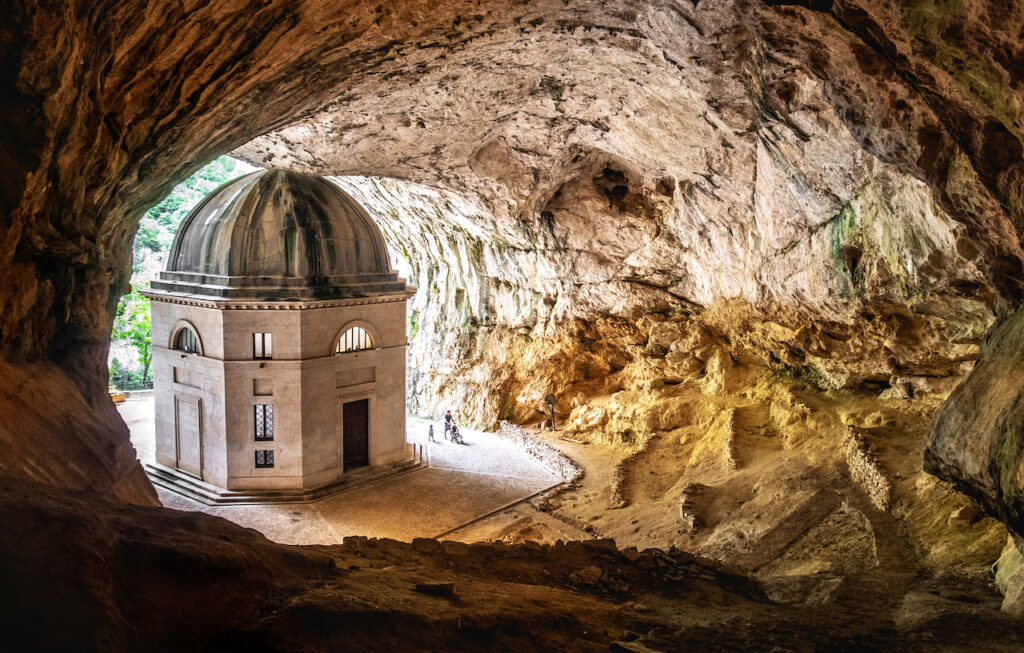
The province of Ancona is famous for hiding a true treasure beneath its mountains: the Frasassi Caves, one of the biggest and most complex cave systems in the world. But these mountains have two other hidden gems that keep surprising visitors of the Regional Natural Park Gola della Rossa e di Frasassi; while driving along the main road inside the gorge, if you look up you may notice a small church inside a cave on the mountain-side.
This amazing building seems to belong in fairytales and seeing that in real life will certainly be an unforgettable experience. A 700-meter-long trail will lead you to the cave but once there you will notice another surprise – a hermitage dug into the stone. This is the Eremo di Santa Maria Infra Saxa (literally “Saint Mary among the stones”), a hermitage that dates back to the 11th century and that proves the long and strong bond this area has with religion and meditation. Not far from here is the famous Abbey San Vittore delle Chiuse, one of the most important religious buildings in the whole region, and during the centuries these mountains have been the home of several hermits looking for peace and silence. While the outside of the hermitage is quite simple, the inside will surprise you with the stone of the mountain incorporated in the building. This place of meditation was then enriched in 1828, when Pope Leone XII had the Tempietto del Valadier built inside the cave next to the hermitage. A true work of art that adds a sense of magic to the place, creating the perfect setting for one of the most praised living nativity of the entire region, which visitors can admire here every Christmas. What was once just a cave on the side of the mountains is now an hidden corner ready and waiting for visitors to explore.
Corinaldo
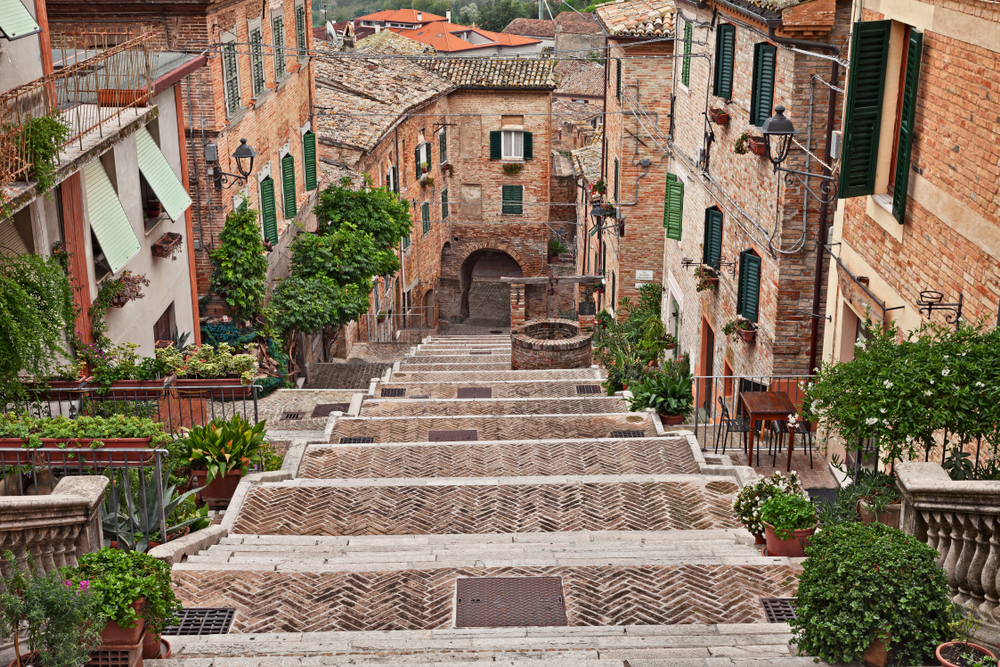
This picturesque village in the hilly countryside of the province on Ancona has collected several monikers, each of which reflects one of its incredible features or legends. The best way to present it is probably through the most rewarding title: “most beautiful village of Italy”, which it gained in 2007.
However, this award is not the only one proving the charm and greatness of this hidden gem of Le Marche; it has also been rewarded with the orange flag of the Italian Touring Club, for being a place of tradition and hospitality, and as “European Destination of Excellence 2008” for its sustainable tourism development. Corinaldo is place where history, works of art, legends and traditions combine, making it a true hidden gem – journalist Mario Carafoli even described it as “the most beautiful village in the world”.
It has an imposing well-preserved medieval city wall, which dates back to the 13th century, picturesque alleys, and the famous Piaggia, a scenic staircase at the centre of the village. These 100 steps split the village in two and halfway is the Pozzo della Polenta, a well which is the symbol of the town and its famous historic festival “Contesa del Pozzo della Polenta”. The legend tells that during the 20-day-long siege of Corinaldo by the Duke of Urbino in the 16th century, a farmer accidentally dropped a bag of corn flour in the well, getting enough polenta for feeding the entire population until the final victory. Celebrations for the end of the siege are re-enacted every year in July together with flag waivers and the historical parade during one of the most famous festivals in the whole region.
Corinaldo is not just medieval history, it also means spirituality. The village is the hometown of the Saint Child, Maria Goretti, who was born here in 1890; tourists and pilgrims can visit the home where she had been living with her family before they all left for Nettuno and the village also hosts the Sanctuary dedicated to her as well as other remarkable churches like Chiesa dell’Addolorata.
The village has a lot of names and one of those is “the town of the crazy people” – which refers to another legend about Scuretto, the cobbler of the village, who preferred to spend all the money his son was sending him from America for drinking and having fun instead for building a house. When his son asked him some pictures of the new home, Scuretto had a façade built so that he could take a convincing picture for his son. He received no more money after that, but today visitors can still see the façade… and take some photos there.
Beach Le Due Sorelle
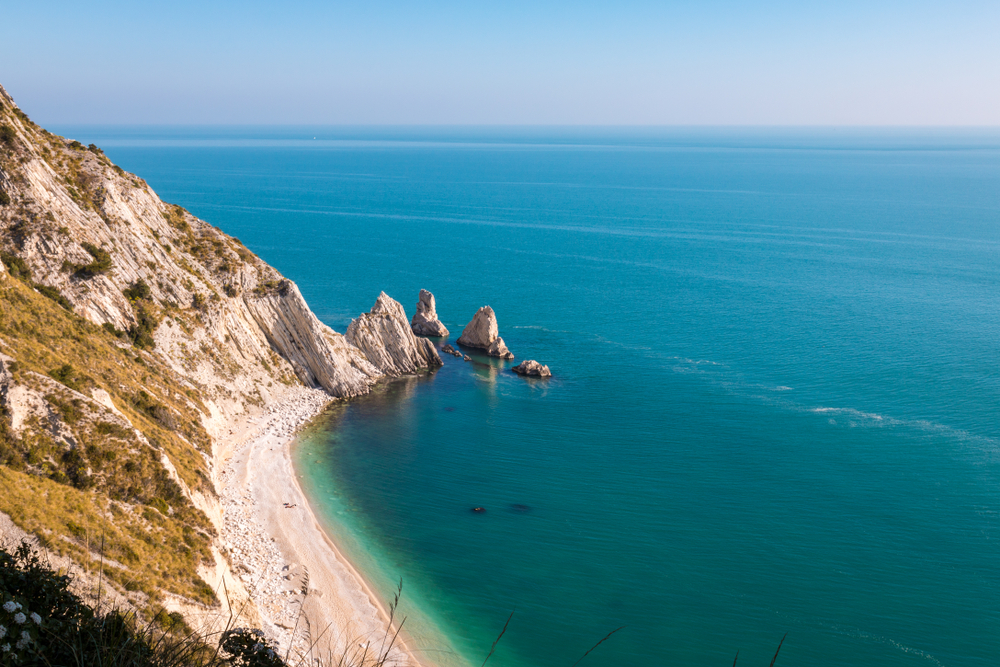
With a literal translation of the “beach of the two sisters”, this hidden corner of paradise derives its name from the two white twin rocks emerging from the sea – traditionally called the two “nuns” praying at the mountain.
It is considered one of the most beautiful beaches in Le Marche and in Italy and it is located at the heart of the Natural Park Monte Conero, a place of natural beauty that extends over 6,000 hectares and has a great variety of flora and fauna. The area is one of the few natural parks where Mediterranean forest is preserved almost untouched and that allows several species of mammals and birds to live here, making it a perfect destination for nature and birdwatching lovers. What makes this area so unique is its high mount, the Conero, that dives vertically into the sea with narrow white sand beaches and white rocks sinking in the blue of the Adriatic. The crystal-clear water and the green of the forest on top of the mountain create a colourful, charming setting for some relaxing hours at the beach.
So – why is Le Due Sorelle so different from other beach resorts? Because it is possible to reach it only by sea. This is the reason why this stunning natural place has been preserved almost untouched, and if you have the chance to visit Conero just before or just after the peak season (late May-early June or September), you would hardly find anyone there. A true corner of paradise, just a few kilometers away from some of the main cities of the region and with excellent ferry connections like its capital Ancona! The ferry lines for Le Due Sorelle leave from three harbors, Numana (only by reservation), Sirolo and Marcelli, but don’t be late! There are just few rides in the morning and the return is early in the afternoon, just before the sun sets behind the Conero, but we assure you that those few hours in this stunning spot will be unforgettable!
Cugnolo Wood and the Lovers’ Cave, Torre di Palma

Do you know that Le Marche has its own ‘Romeo and Juliet’? Antonio and Laurina, unlike the famous lovers of Shakespeare’s drama, are not fictional characters, but their passionate love and its tragic ending recall the tragedy of the two lovers from Verona. In 1911 the 24-year-old Antonio was forced to leave his betrothed, the 19-year-old Laurina, and head towards Libya to fight in the Italian Colonial War. This separation was agony for both of them, Laurina even learned how to read and write in order to send love letters to his beloved fiancé until finally Antonio could come back home on leave. The two lovers decided to run away together; they found shelter in the wood near their hometown, Torre di Palma, and spent eight days and eight nights in a cave thanks to the help of some local fishermen that brought them bread and fish. However, the army was looking for them – Antonio was a deserter and his treason was punishable by death. The two lovers tried to find another place, they found shelter in a small church but when they realised they were about to be caught, they decided to end their lives together by throwing themselves into Fosso San Filippo, a 70-meter-high cliff near Torre di Palma.
Their tragedy became of the most romantic and passionate stories of this place, the cave where Antonio and Laurina spent their last days became famous as the Lovers’ Cave and today people can still see it in the fascinating setting of the Cugnolo wood. This a Protected Natural Area of Le Marche, where visitors can admire one of the most well-preserved areas of Mediterranean forest and follow the two-kilometre-long trail inside the wood, with some beautiful views over Torre di Palma and the coastline behind it. Located on the top of a hill facing the sea and surrounded by cultivated fields and vineyards, Torre di Palma is undoubtedly one of the most picturesque villages in Le Marche, where visitors can take a plunge back in time while strolling along its narrow, cobbled streets and with beautiful views over the coastline of Le Marche from Piazzale Belvedere. Near the village and the wood is also Villa degli Aranci, an amazing noble property dating back to the 17th century, which is famous for orange and citrus fruit plants growing there. A place of tradition and romance, spectacular views and nature – Torre di Palma and its surroundings are definitely one of the best hidden gems of Le Marche.
Urbisaglia Theatre and Amphitheatre
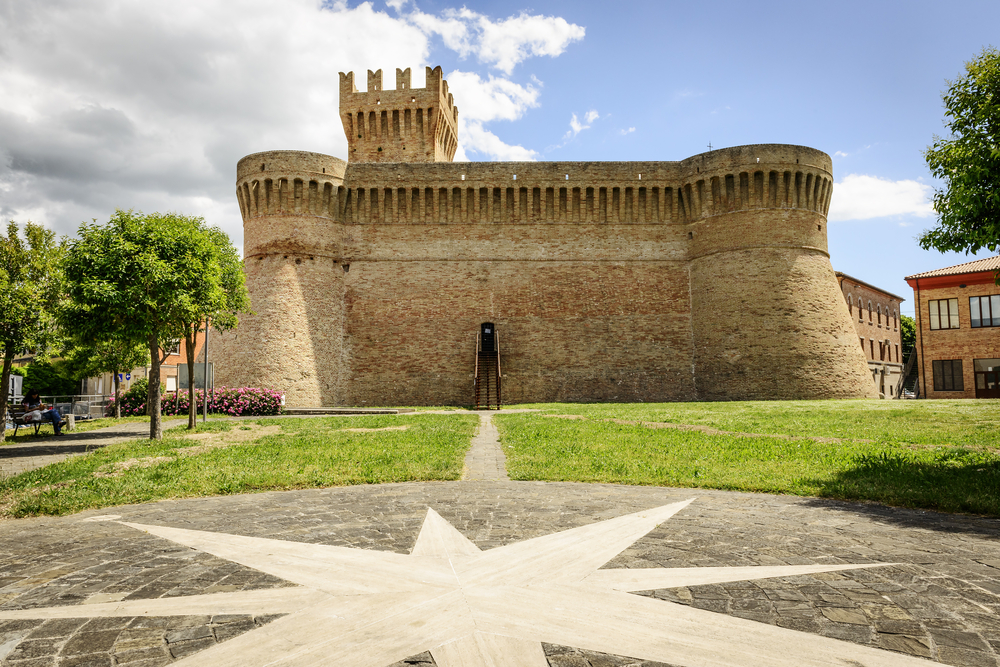
Now a hilltop village with 2,500 inhabitants near Matera, Urbisaglia looks no different from the hundreds of medieval villages that are a distinctive feature of this region. In the historic centre visitors can stroll along the narrow streets and admire imposing palaces as well as the famous Rocca, which was built in the 16th century to face riots against the domination of the nearby town of Tolentino. However, this little village is not like the others, since it hides a glorious ancient past. Before the medieval village was built on the top of the hill, along the Via Salaria Gallica was the Roman town Urbs Salvia, an important colony of Rome that peaked during the governance of the emperors Augustus and Tiberius. The traces of that glorious past are still visible today in the great Archaeological Park of Urbs Salvia, where visitors have the chance to admire the remains of the Roman colonisation of the area as well as one of the most well-preserved Roman theatres. Among the lush vegetation of Le Marche countryside, you will see the ancient city walls and the remains of a temple still with traces of original frescos on the walls. The great attractions of the Park are then the imposing remains of the theatre and the amphitheatre of Urbs Salvia, the last ones being located outside the city walls. Looking at the arena where gladiators used to fight and actors used to play as well as at the same steps from where spectators were watching them is a truly unforgettable experience. And if you want to feel what is like to watch a play in this amazing setting, do not miss the Season of Ancient Theatre hosted every summer in the Amphitheatre. What a better plunge back in ancient times than to relive them (minus the gladiators, of course…).
Convinced? Check out our villas in Le Marche – we have a few hidden gems there, too.


